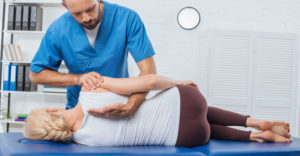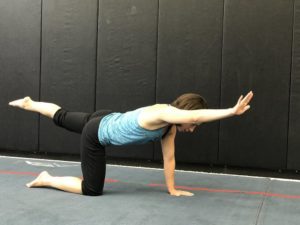What is Degenerative Scoliosis?
Degenerative scoliosis is a side to side curvature of the spine that is the result of degeneration of facet joints and spinal discs. That means the spine curves over time with age, which is different from an adolescent scoliosis. There may be associated pain with degenerative scoliosis from mild back ache to very painful shooting sensations down the lower back and legs. Sciatica can happen because of scoliosis which can make walking difficult.
Adult Degenerative Scoliosis
Facet joints in the spine are basically hinges in your spine that help your spine bend and curve. Intervertebral discs also assist by absorbing shock between vertebrae when bending, but when these two parts of the spine degenerate unevenly adult onset scoliosis is the result. The asymmetrical degeneration causes tilting and slipping in the vertebrae. This has a cascade effect from one level to the next and thus adult degenerative scoliosis begins to develop. Typically this will have an impact on the lower back or lumbar spine. Because the scoliosis is caused by degeneration, there can be other ailments such as degenerative disc disease or arthritis that causes pain. If the spine curves 10 degrees or more to one side then that is called scoliosis.
As many as 60% of the population over the age of 60 has some kind of scoliosis, usually a mild case of degenerative scoliosis that doesn’t cause any significant symptoms.
Pain from Scoliosis
The pain that results from scoliosis begins as a dull ache or stiffness in the lower back, and develops into a pins and needles sensation that radiates into a leg. The leg pain can become sharp and make it difficult to walk. In this case it’s a good idea to see a doctor and pursue a treatment plan to resolve your pain. These types of pain are caused by a pinched nerve in the spine, or inflammation in the degenerated joints. In the case of a pinched nerve this is called a herniated disc which compresses a nerve in the spine.
Sciatica is the name for the pain radiating from the back to the legs, because it’s caused by the sciatic nerve, which runs all the way from your lower back down to your feet. The actual curve in the spine is rarely the cause of painful symptoms, and may not even need to be corrected to relieve symptoms.
Diagnosing Adult Scoliosis
To determine whether or not you have adult scoliosis a doctor will go over your medical history as well as family medical history, and also perform a physical examination, and neurological exam. While all of these diagnosing devices have their place in determining a condition, imaging tests will be the most conclusive technique to confirm a scoliosis diagnosis.
An X-ray will show the full curve of the spine and are the go to imaging technique to see how much your scoliosis has developed. X-rays from different positions will be taken like from the front, side, and perhaps a side bending X-ray to see the flexibility of your spine. However, if you have other symptoms like numbness or tingling in a leg your doctor will likely order an MRI scan to see where the pain is coming from exactly. MRI, or magnetic resonance imaging, machines are specially suited to see the inner workings of the spine including nerves that might be compressed, and if there are any problems with the spinal cord, spinal discs, vertebrae and anything else that has to do with the spine.
 Degenerative Scoliosis Treatment
Degenerative Scoliosis Treatment
Much of the time degenerative scoliosis can be treated non-surgically with guidance from a medical professional to ensure your symptoms subside. If the symptoms are too severe or non-surgical medical interventions aren’t working, your doctor may recommend further treatments. What are the initial treatments though? Physical therapy is your first line of defense against scoliosis and painful symptoms that come with the condition. And that means exercise.
Degenerative Scoliosis Exercises

When you begin a physical therapy routine your physical therapist or medical professional creates an exercise and stretching routine that is catered to your ability level, and what your medical condition allows. It’s important to build strength in the appropriate muscles, as well as keep the joints limber, but not to overdo it and cause more harm than help. Exercising in the pool is a great way to exercise and build strength while putting much less stress on the joints of your spine. Massage can be a good supplement to exercise because it helps with blood circulation and making the muscles less tense.
The arm/leg raise is a good exercise that helps strengthen lower back muscles plus core muscles which all work together to support your spine. To perform the scoliosis exercise you lay down on your stomach while keeping legs and arms straight out, and raise one arm off the ground for a moment. You can repeat this 15 times with each arm/leg, or even make it harder by raising opposite arms and legs at the same time while supporting your weight with one hand / knee on the floor.
 If you’ve ever done yoga the cat/cow stretch is simple, and stretches the supporting muscles around your spine. All you have to do is place your knees and palms on the ground looking forward and arch your back like a cat, then bend it downwards in the opposite direction like a cow I suppose. You’ll want to make the movements slow and hold the positions briefly and remember to breathe during the motion.
If you’ve ever done yoga the cat/cow stretch is simple, and stretches the supporting muscles around your spine. All you have to do is place your knees and palms on the ground looking forward and arch your back like a cat, then bend it downwards in the opposite direction like a cow I suppose. You’ll want to make the movements slow and hold the positions briefly and remember to breathe during the motion.
Idiopathic Scoliosis vs Degenerative
We’ve been over what degenerative scoliosis is caused by, which is the natural aging of the spine. Idiopathic scoliosis doesn’t have a known cause though, and begins during adolescence. Degenerative is called Adult Onset Scoliosis, while idiopathic is called Adolescent Scoliosis due to the time period in which they start affecting the patient. Even if idiopathic scoliosis starts in adolescence it might not be found out until much later when the scoliosis starts causing pain or issue in the person’s day to day life.


